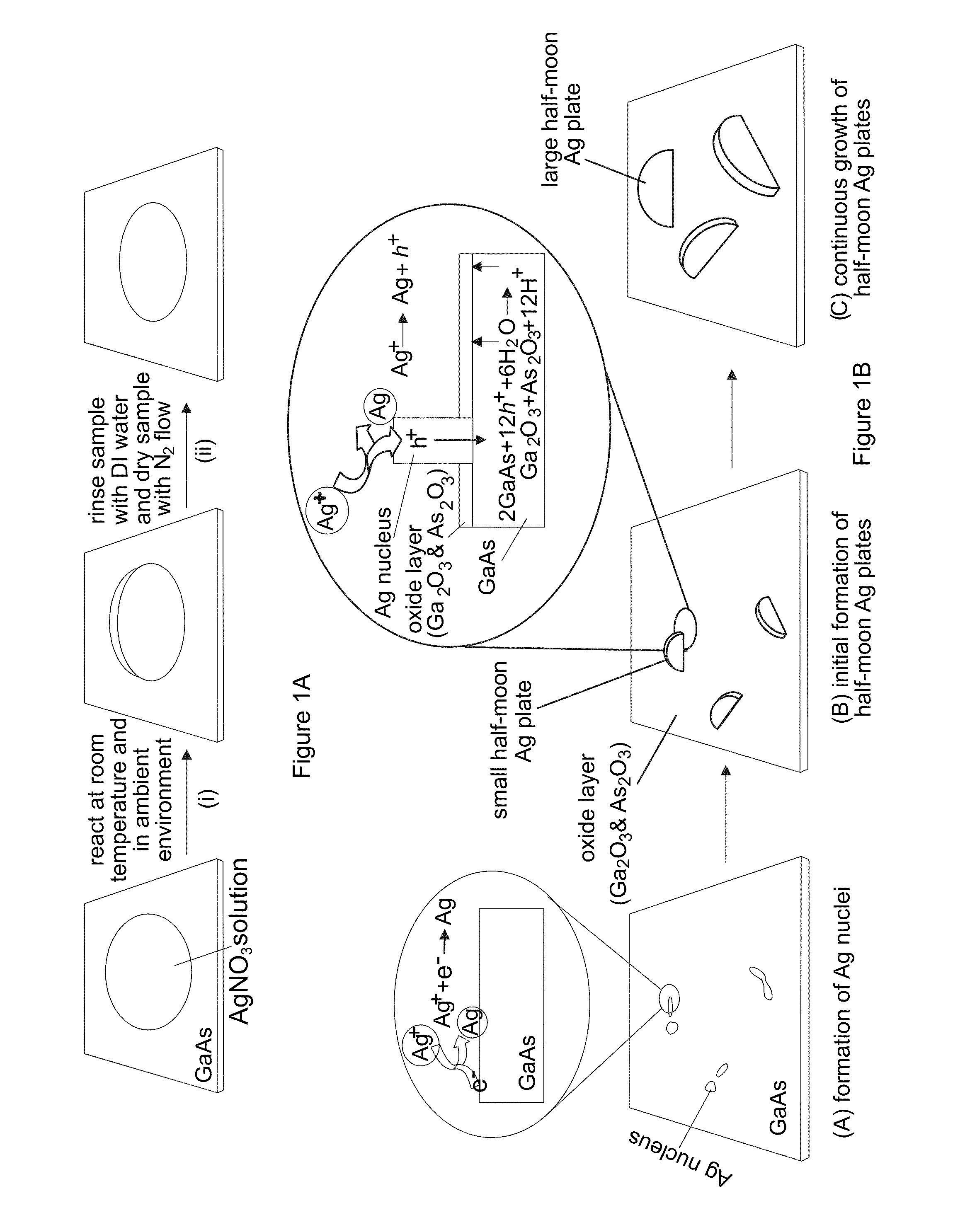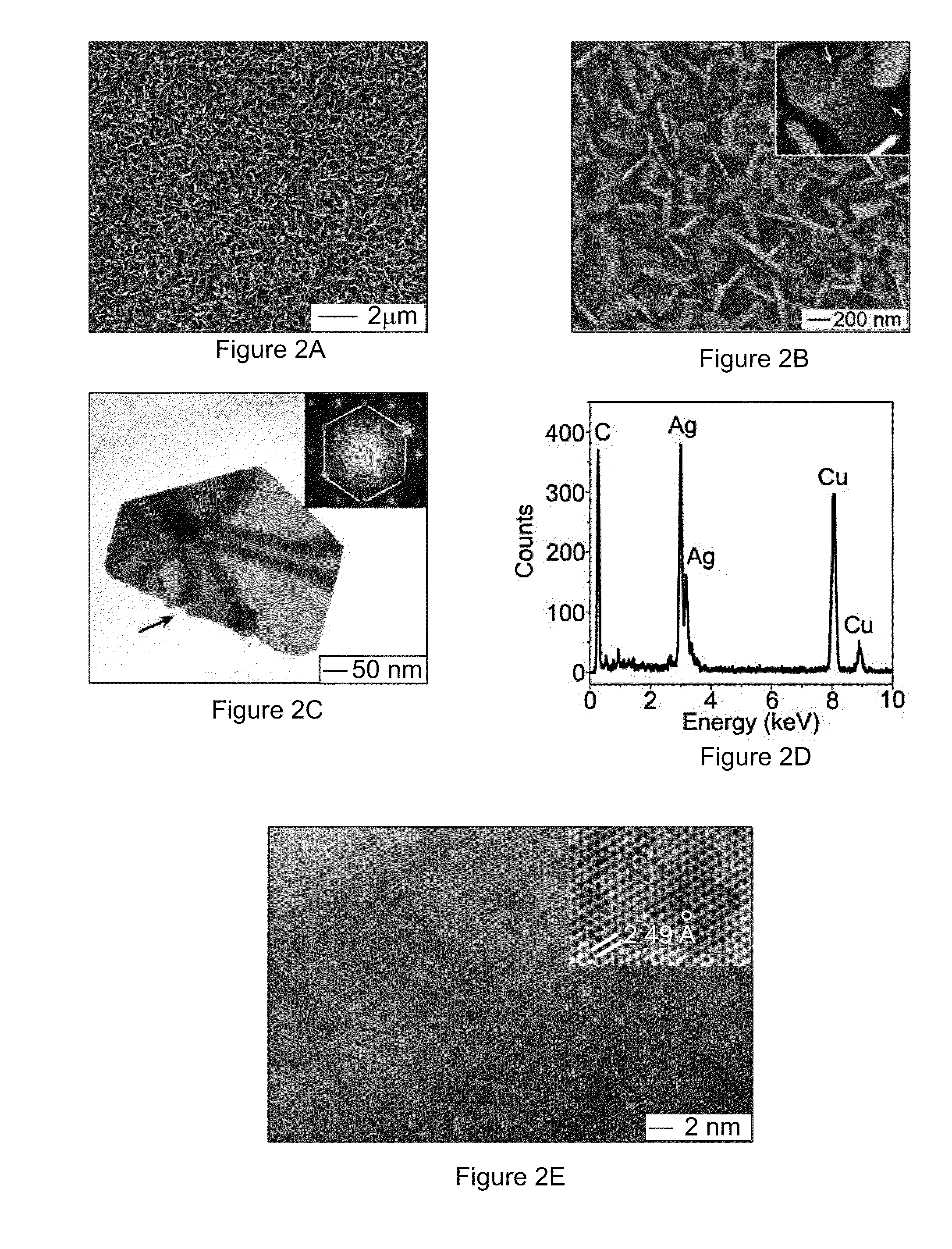Direct growth of metal nanoplates on semiconductor substrates
a technology of metal nanoplates and substrates, applied in the direction of final product manufacturing, liquid/solution decomposition chemical coating, sustainable manufacturing/processing, etc., can solve problems such as surface roughness, and achieve the effects of large facial area, large facial area, and smooth surfa
- Summary
- Abstract
- Description
- Claims
- Application Information
AI Technical Summary
Benefits of technology
Problems solved by technology
Method used
Image
Examples
example 1
[0090]With reference to FIGS. 12A-12C, the nucleation and growth of Ag nanoplates on an n-type single crystal GaAs substrate through reaction with a substantially pure aqueous solution of AgNO3 is illustrated. In a typical synthesis, a droplet of aqueous solution of AgNO3 with appropriate concentration, from about 0.1 M to about 10 M, is delivered to the surface of a piece of n-type GaAs wafer that has been cleaned by soaking in a dilute 2% hydrofluoric acid (HF) solution for 5 minutes. Contacting the GaAs wafer with AgNO3 solution immediately leads to quick reduction of Ag+ by the surface electrons (as shown in FIG. 12A), resulting in the formation of small Ag clusters (i.e., nuclei) on the nucleation sites (usually surface defects) on the GaAs surface. Once the nuclei are formed, hole injection process dominates the growth of the nuclei into larger Ag particles because the equilibrium potential (greater than or equal to 0.74 V versus NHE for AgNO3 solutions with concentrations hig...
example 2
[0096]The size of the nanoplates can be tuned by controlling the growth time. FIGS. 14A and 14B compare the Ag nanoplates obtained by reacting n-GaAs wafers (with dopant concentration of 1×1018 cm−3) with a 2 M AgNO3 solution for 30 seconds and 60 seconds, respectively. The nanoplate sizes, which are determined by measuring the lengths of the orthographic projections of individual nanoplates along their longitudinal axes in the surface of the substrate, increase from about 125 nm to about 210 nm with increasing growth time from 30 seconds to 60 seconds. On the other hand, the thicknesses of the nanoplates remain substantially constant at about 22 nm. The dimensional evolution of the Ag nanoplates upon growth time indicates that growing a Ag nanoplate may start with the formation of a Ag nucleus at a defect site of the GaAs surface because the defect site has higher surface energy, thus higher reactivity, than adjacent flat areas. The lateral dimension of the Ag nucleus may be consis...
example 3
[0097]The thicknesses of Ag nanoplates can also be finely tuned by controlling the concentration of AgNO3 solution. Silver nanoplates with smooth surfaces can be achieved on the n-GaAs wafers by reacting with AgNO3 solutions with concentrations ranging from 1 M to saturation concentration, about 10 M. FIGS. 14D and 14E show typical SEM images of the samples prepared through reactions with 6 M and 8 M AgNO3 solutions for 60 seconds, respectively. The comparison between the samples grown with different concentrations of AgNO3 solutions for the same time, 60 seconds, indicates that the thicknesses of nanoplates increase with concentrations of the AgNO3 solutions but their sizes remain substantially constant. The independence of the sizes of the Ag nanoplates on the concentrations of AgNO3 solutions implies that the rate for adding Ag atoms to the peripheral edge surfaces of the nanoplates is determined by the kinetics of the hole injection process rather than the diffusion of Ag+ ions....
PUM
| Property | Measurement | Unit |
|---|---|---|
| diameter | aaaaa | aaaaa |
| contact angles | aaaaa | aaaaa |
| temperature | aaaaa | aaaaa |
Abstract
Description
Claims
Application Information
 Login to View More
Login to View More - R&D
- Intellectual Property
- Life Sciences
- Materials
- Tech Scout
- Unparalleled Data Quality
- Higher Quality Content
- 60% Fewer Hallucinations
Browse by: Latest US Patents, China's latest patents, Technical Efficacy Thesaurus, Application Domain, Technology Topic, Popular Technical Reports.
© 2025 PatSnap. All rights reserved.Legal|Privacy policy|Modern Slavery Act Transparency Statement|Sitemap|About US| Contact US: help@patsnap.com



